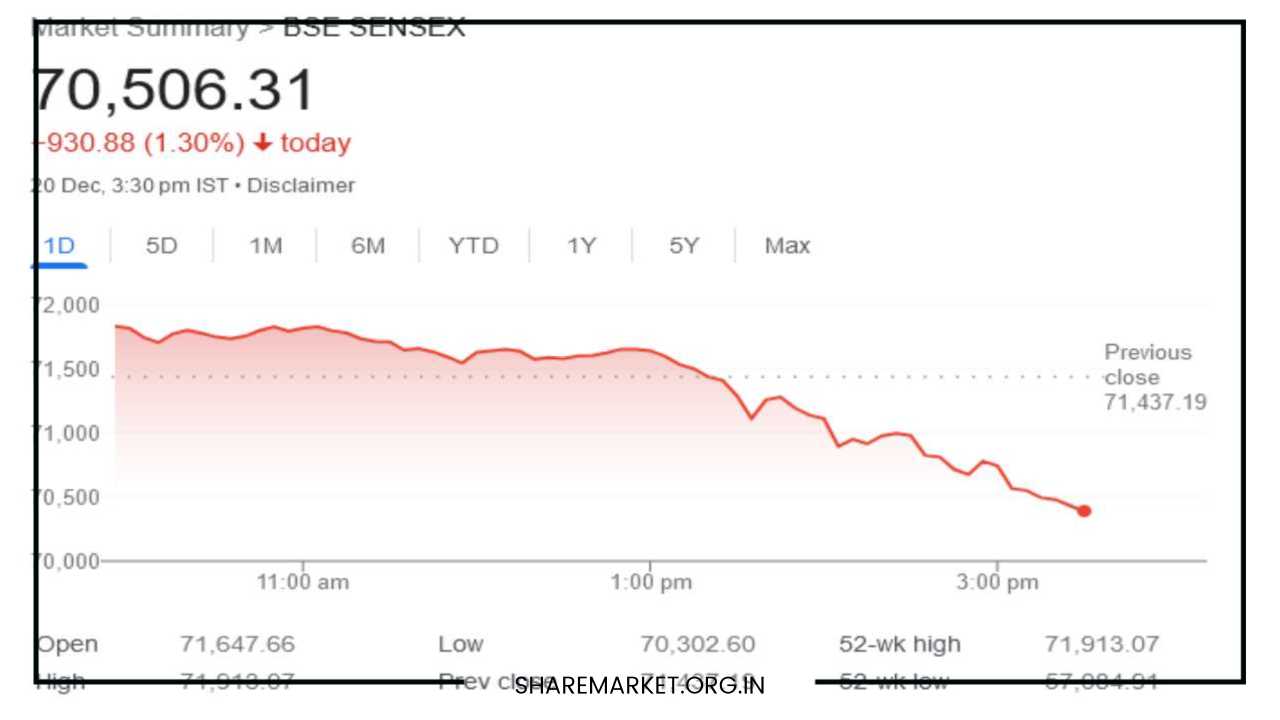Stock Market Crash Today: ₹9.32 Lakh Crore Wiped Out in a Single Day

Stock Market Crash Today
Unprecedented Market Turbulence: A Deep Dive into the Indian Stock Market Plunge on December 20
The Indian stock market witnessed an unprecedented downturn on December 20, sending shockwaves through the financial landscape.
The Sensex, comprising 30 leading stocks, experienced a staggering decline of 931 points, marking a rare occurrence where all 30 Sensex stocks found themselves in negative territory—a phenomenon not seen in many years.
This drastic market correction was attributed to weak global cues, revealing the interconnected nature of global financial markets.
The repercussions of this event were far-reaching, resulting in chaos within the market and substantial losses for investors, totaling approximately ₹9.32 lakh crore in a single day.
The All-Encompassing Market Decline:
The root cause of the market upheaval was the influence of weak global cues, which triggered a domino effect across the Indian stock exchanges.
This was an exceptional event, as it marked the first time in many years that all 30 Sensex stocks remained in the red.
The severity of the downturn was evident as the BSE midcap and smallcap indices both registered declines exceeding 3%, indicating a comprehensive market correction.
Sectoral Impact:
The market decline was not limited to specific sectors but manifested as an all-encompassing phenomenon.
All sectoral indices closed in negative territory, with the power, utility, telecom, and services sectors experiencing the most significant declines.
The widespread nature of the market turbulence underscored the challenges faced by investors across various industries.
Sensex and Nifty Performance:
At the close of the trading day, the BSE’s 30-share index, Sensex, stood at 70,506.31 points, reflecting a sharp decline of 930.88 points or 1.30%.
Simultaneously, the NSE’s 50-share index, Nifty, witnessed a substantial drop of 346.70 points or 1.62%, concluding at 21,106.40.
These figures highlighted the depth of the market correction and raised concerns about the broader economic implications.
Impact on Investor Wealth:
The toll on investors was evident as the market capitalization of companies listed on BSE experienced a significant contraction.
On December 20, the total market capitalization came down to ₹349.79 lakh crore, compared to ₹359.11 lakh crore on the previous trading day (December 19).
This translated to a staggering decrease of about ₹9.32 lakh crore in market capitalization, signifying a substantial erosion in investor wealth within a single trading session.
Individual Stock Performance:
The severity of the market downturn was underscored by the fact that not a single Sensex stock emerged unscathed.
All 30 stocks closed with declines, reflecting the pervasive nature of the market sell-off. Tata Steel shares were the top loser, witnessing a substantial fall of 4.73%.
Other notable losers included HCL Tech, State Bank of India (SBI), Tech Mahindra, and Tata Motors, each registering declines ranging from 3.13% to 3.44%.
The breadth and depth of the decline across all sectors and stocks highlighted the widespread nature of the market correction.
Broader Market Reflection:
The broader market reflected the widespread decline, with 3,175 shares closing in negative territory on the Bombay Stock Exchange (BSE).
Out of the 3,921 shares traded, only 661 managed to close with gains. In contrast, 85 shares remained flat without any fluctuations.
This high number of declining shares indicated a pervasive trend of sell-offs across various stocks, contributing to the overall market turmoil.
52-Week Highs and Lows:
During the trading session, 352 shares reached their new 52-week high, while 28 shares touched their new 52-week low.
This dynamic showcased the extreme volatility and uncertainty that characterized this tumultuous day in the stock market.
Investors faced challenging decisions amid rapidly changing market conditions, with some stocks reaching new highs while others plummeted to new lows.
The heightened volatility underscored the challenges and risks associated with navigating financial markets during periods of extreme turbulence.
Discussion:
Factors Contributing to the Downturn:
Market analysts and experts scrambled to provide insights into the factors contributing to the unprecedented decline.
Weak global cues, stemming from geopolitical tensions, economic uncertainties, and external shocks, were identified as primary catalysts.
The interconnected nature of global financial markets meant that events in one part of the world could trigger cascading effects across borders, amplifying the impact on domestic markets.
Economic Concerns and Policy Response:
Furthermore, concerns about inflation, interest rates, and the overall economic outlook added to the complexity of the situation.
Central banks and policymakers faced the challenge of calibrating responses to address the evolving economic landscape and restore market confidence. T
he delicate balance between monetary policy measures, fiscal interventions, and regulatory actions became crucial in mitigating the fallout from the market downturn.
Investor Decision-Making Amid Uncertainty:
In the aftermath of the decline, investors grappled with critical decisions regarding portfolio reallocation, risk mitigation, and strategic planning.
The sudden and sharp correction prompted a reassessment of asset allocation strategies, with a focus on diversification and risk management.
Investors sought refuge in traditional safe-haven assets such as gold and government bonds, underscoring the flight to safety amid heightened market uncertainties.
Impact on Individual Stocks and Sectors:
The market correction also triggered a reassessment of individual stocks and sectors.
Companies with robust fundamentals and resilient business models were seen as more likely to weather the storm, while those with vulnerabilities faced heightened scrutiny.
The role of corporate governance, financial health, and adaptability to changing market conditions became central considerations for investors navigating the post-correction landscape.
Final Thoughts:
In conclusion, the significant decline in the Indian stock market on December 20, marked by a rare occurrence of all 30 Sensex stocks closing in the red, was a watershed moment with far-reaching implications.
The rapid and widespread nature of the correction underscored the interconnectedness of global financial markets and the challenges of navigating uncertainties in the contemporary economic landscape.
Investors, analysts, and policymakers alike were prompted to reflect on the resilience of financial markets, risk management practices, and the need for proactive measures to enhance market stability in the face of external shocks.
The episode served as a critical juncture for market participants to reassess strategies, enhance transparency, and fortify the financial system against future uncertainties.

















